Planning worship?
Check out our sister site, ZeteoSearch.org,
for 20+ additional resources related to your search.
- |
User Links
Person Results
Thomas M. Westrup
1837 - 1909 Person Name: T. M. Westrup Translator of "Sol de mi ser, mi Salvador" in Himnario provisional con los cánticos Thomas Martin Westrup moved with his family from London to Mexico when he was fifteen years old. He translated hundreds of hymns and, along with his son, Enrique, published a three-volume hymnal Incienso Christiano.
Dianne Shapiro from Celebremos su Gloria (Colombia/Illinois: Libros Alianza/Celebration), 1992
Thomas M. Westrup
William Rees
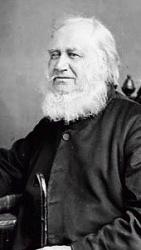
1802 - 1883 Person Name: W. R. Author (stanzas 1-3) of "Erfyniwn, Arglwydd, ger dy fron" in Mawl a chân = praise and song
William Rees
Frederic Henry Hedge

1805 - 1890 Author of "In love to God and love to man" in Jubilate Deo Hedge, Frederick Henry, D.D., son of Professor Hedge of Harvard College, was born at Cambridge, Massachusetts, 1805, and educated in Germany and at Harvard. In 1829 he became pastor of the Unitarian Church, West Cambridge. In 1835 he removed to Bangor, Maine; in 1850 to Providence, and in 1856 to Brookline, Mass. He was appointed in 1857, Professor of Ecclesiastical History at Cambridge (U.S.), and in 1872, Professor of German Literature at Harvard. Dr. Hedge is one of the editors of the Christian Examiner, and the author of The Prose Writers of Germany, and other works. In 1853 he edited, with Dr. F. D. Huntington, the Unitarian Hymns for the Church of Christ, Boston Crosby, Nichols & Co. To that collection and the supplement (1853) he contributed the following translations from the German:—
1. A mighty fortress is our God. (Ein feste Burg.)
2. Christ hath arisen! joy to, &c. (Goethe's Faust.)
3. The sun is still for ever sounding. (Goethe's Faust.)
There is also in the Unitarian Hymn [& Tune] Book for The Church & Home, Boston, 1868, a translation from the Latin.
4. Holy Spirit, Fire divine. (“Veni Sancte Spiritus.")
Dr. Hedge's original hymns, given in the Hymns for the Church, 1853, are:—
5. Beneath Thine hammer, Lord, I lie. Resignation.
6. Sovereign and transforming grace. Ordination. Written for the Ordination of H. D. Barlow at Lynn, Mass., Dec. 9, 1829. It is given in several collections.
7. 'Twas in the East, the mystic East. Christmas.
8. 'Twas the day when God's anointed. Good Friday. Written originally for a Confirmation at Bangor, Maine, held on Good Friday, 1843. The hymn "It is finished, Man of Sorrows! From Thy cross, &c," in a few collections, including Martineau's Hymns, &c, 1873, is composed of st. iv.-vi. of this hymn. [Rev. F. M. Bird, M.A.]
--John Julian, Dictionary of Hymnology (1907)
Frederic Henry Hedge
Frank Mason North
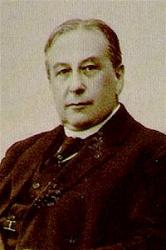
1850 - 1935 Author of "Where cross the crowded ways of life" in Hymns of the Kingdom of God North, Frank Mason, D.D., b. at New York, Dec. 3, 1850, graduated at Wesleyan University 1872, and entered the ministry of the Methodist Episcopal Church 1872. In 1892 he became Correspondence Secretary of the New York City Church Extension and Missionary Society, and is now (1905) editor of The Christian City. His hymns in common use include:—
1. Jesus, the calm that fills my breast. [Peace.] In The Plymouth Hymnal,1894; Sursum Corda, 1898; The Methodist Hymnal, 1905, &c.
2. When cross the crowded ways of life. [City Missions.] In The Methodist Hymnal, 1905. [Rev. L. F. Benson, D.D.]
--John Julian, Dictionary of Hymnology, New Supplement (1907)
=================
North, Frank Mason, D.D. (December 3, 1850--December 17, 1935). The Appendix Index reference, p.1607 in Julian, to Dr. North is to John Post Attwater who used "Frank North" as his nom de plume. In addition to the information included in the short biographical sketch at p.1677 it should be added that Dr. North continued his studies at Wesleyan University, advancing to the M.A. degree in 1875, later being honored by that institution's D.D., 1894, and L.L.D., 1918. He was a member of the New York East Conference of the Methodist Episcopal Church and served several pastorates in New York State and City as well as one at Middletown, Connecticut, 1887-1892. During the years 1892-1912, while Corresponding Secretary of the New York City Extension and Missionary Society and the editor of The Christian City, he was also Corresponding Secretary of the National City Evangelical Union of the Methodist Episcopal Church. From 1912 to 1924 he was the Secretary of the Board of Foreign Missions of his church and through these years he served as Chairman of its Executive Committee. He was also Secretary, Chairman of the Executive Committee, and President of the Federal Council of the Churches of Christ in America. It was largely through his efforts and influence that the Federal Council was organized.
Trustee and member of governing boards of numerous institutions in the United States, China, and Japan, among the additional honors which came to him were Chevalier Legion of Honor and "Officer de l'Instruction Publique," France; Officer of the Royal Order of George I, Greece. He was one of the great Protestant leaders of his generation. The leading article in The Hymn, 30 April 1950, was an excellent appreciation of Dr. North and his work.
Sources: Handbooks of various hymnals; Who Was Who I; Foote, Henry Wilder, Three Centuries of American Hymnody; Ninde, Edward S., Story of the American Hymn; Bailey, ALbert E., The Gospel in Hymns; Pratt, John Barnes, Present Day Hymns; correspondence.
--Robert G. McCutchan, DNAH Archives
Frank Mason North
Henry Twells
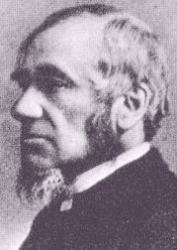
1823 - 1900 Person Name: Canon Henry Twells Author of "At even, when the sun was set" in The Book of Common Praise Twells, Henry, M.A., was born in 1823, and educated at St. Peter's College, Cambridge. B.A. 1848, M.A. 1851. Taking Holy Orders in 1849, he was successively Curate of Great Berkhamsted, 1849-51; Sub-Vicar of Stratford-on-Avon, 1851-54; Master of St. Andrew's House School, Mells, Somerset, 1854-56; and Head Master of Godolphin School, Hammersmith, 1856-70. In 1870 he was preferred to the Rectory of Baldock, Herts, and in 1871 to that of Waltham-on-the Wolds. He was Select Preacher at Cambridge in 1873-74, and became an Honorary Canon of Peterborough Cathedral in 1884. Canon Twells is best known by his beautiful evening hymn, "At even ere the sun was set." He also contributed the following hymns to the 1889 Supplemental Hymns to Hymns Ancient & Modern:—
1. Glorious is Thy Name, O Lord. The Name of God.
2. Know ye the Lord hath borne away? Ascension.
3. Not for our sins alone. Plea for Divine Mercy.
4. The voice of God's Creation found me. The Word of God a Light.
-- John Julian, Dictionary of Hymnology (1907)
==================
Twells, H., p. 1189, i. Canon Twells was born on March 13, 1823, at Ashted, Birmingham, and died at Bournemouth, Jan. 19, 1900. His Memoir, by W. Clavell Ingram, D.D., was published in 1901. His Hymns and other Stray Verses, appeared in 1901i. From it the following additional hymns have come into common use:—
1. Spirit of Truth and Might, 'Tis Thou alone can teach. [Our Words.] On "The Responsibility of Speech," p. 26. In the Sunday School Hymnary, 1905.
2. The day of Pentecost is fully come. [Whitsuntide.] Usually the second stanza is taken as the opening of this hymn. In this form it is given as "Awake, 0 Lord, as in the days of old," in Hymns Ancient & Modern, 1904, the Sunday School Hymnary, 1905, and other collections.
--John Julian, Dictionary of Hymnology, New Supplement (1907)
Henry Twells
Peter Ritter
1760 - 1846 Composer of "[Sun of my soul, thou Saviour dear]" in Joyful Lays Peter Ritter; b. 1760, Mannheim; d. 1846
Evangelical Lutheran Hymnal, 1908
Peter Ritter
Charles H. Webb
b. 1933 Person Name: Charles H. Webb Composer (descant) of "HURSLEY" in The United Methodist Hymnal Music Supplement
Charles H. Webb
Christian Knorr von Rosenroth
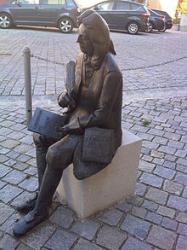
1636 - 1689 Person Name: C. K. v. Rosenroth Author of "Morgenglanz der Ewigkeit!" in Gesangbuch mit Noten Knorr, Christian, Baron von Rosenroth, son of Abraham Knorr yon Rosenroth, pastor at Altrauden in Silesia, was born at Altrauden, July 15, 1636. After studying at the Universities of Leipzig (where he graduated M.A. 1659, along with J. B. Carpzov, the famous Orientalist) and Wittenberg, he made an extended tour through France, England, and Holland. At Amsterdam he became acquainted with an Armenian prince, with the chief Rabbi, Meier Stern, from Frankfurt-am-Main, with Dr. John Lightfoot, Dr. Henry More, and others, and as the result of intercourse with them, devoted himself to the study of the Oriental languages, of chemistry, and of the cabalistic sciences. For his learning in these departments he was taken into the service of the like-minded Palsgrave Christian August of Sulzbach, who in 1668 appointed him Geheimrath and prime minister (Kanzlei-director). He was created Baron von Rosenroth by the Emperor Leopold I. in 1677, and died at Sulzbach (near Amberg, Bavaria), May 8, 1689, it is said at the hour he had himself predicted. (Wetzel, ii. 43, and A. H., ii. 444; Hömer's Nachrichten von Liederdichtern, Schwabach, 1775, p. 142, &c.)
Knorr edited various Rabbinical writings, published various cabalistic works (e.g. his Kabbala denudata, 2 vols., Sulzbach, 1677), and was one of the seekers after the philosopher's stone. His hymns appeared as Neuer Helicon mit seiner Neun Musen, das ist: Geistliche Sitten-Lieder, &c. Nurnberg, 1684 [Hamburg Library], a work containing 70 hymns mostly flowing in expression and metre. Of these 12 are poetic versions from Boethius's De Consolatione Philosophiae, 8 are from Latin hymns, and 8 are recasts of older German hymns. Sixteen of his hymns were included by Freylinghausen in his Gesang-Buch, 1704 and 1714. Koch speaks of them not unjustly as "truly pious and spiritual," as "of genuine poetical elevation and glowing desire after inner union with Christ," and as the fruits of a "noble and chastely earnest mysticism."
Two of Knorr's hymns have passed into English. One is a translation of "Ad coenam Agni" (p. 12 ii.). The other is
Morgenglanz der Ewigkeit. Morning. This fine hymn appeared, 1684, as above, p. 159, in 7 st. of 6 1., entitled " Morning Prayer," and is included in the Berlin G. L. 8., ed. 1863, No. 1121. It is based on a hymn by M. Opitz, but is more happily expressed, and has attained much greater popularity. Fischer, ii. 94, speaks of it as "one of the freshest, most original, and spirited of Morning Hymns, as if born from the dew of the sunrise." In all the translations in common use, st. ii., v. are omitted. Translated as:—
1. Light of heaven's eternal day! A good translation by A. T. Russell, as No. 68 in the Dalston Hospital Hymn Book, 1848, repeated in his own Psalms & Hymns, 1851, and the Cheltenham College Hymn Book, 1866.
2. Dayspring of Eternity! Dawn on us this morning-tide. A good translation by Miss Winkworth in her Lyra Germanica, 1st Ser., 1855, p. 219. In full in the Hymnal for St. John's, Aberdeen, 1870, and E. Courtauld's Psalms, Hymns & Anthems, 1860; and abridged in Hymns of the Spirit Boston, U. S., 1864, Dr. Martineau's Hymns, 1873, and others.
3. Jesus, Sun of Righteousness. A good but rather free translation by Miss Borthwick, in Hymns from the Land of Luther, 2nd Ser., 1855, p. 23 (1884, p. 88), included in the Hymnal Companion, 1876; Evangelical Union Hymnal, 1878; Church Praise, 1883, &c.; and in America in the Sabbath Hymn Book, 1858; Pennsylvania Lutheran Church Book, 1868, and others. In E. T. Prust's Supplemental Hymn Book, 1869, Baptist Hymnal, 1879, and others, 1 l. 5, 6 of each st. are omitted. In Hatfield's Church Hymn Book, N. Y., 1872, Hymns & Songs of Praise, N. Y., 1874, and others, it is rewritten to 6 lines of 7's.
4. Come, Thou bright And morning star. A good translation contributed by R. Massie to the 1857 ed. of Mercer's The Church Psalter & Hymnbook., No. 502 (Ox. ed. 1864, No. 1), and in his own Lyra Domestica, 18&4, p. 136. Repeated in R. Minton Taylor's Hymnal, 1872, No. 42; Marlborough College Hymn Book, 1869 ; Rugby School Hymn Book, 1876, and others.
5. Sun of heaven's eternal day. A good translation contributed by Dr. John Ker to the United Presbyterian Juvenile Mission Magazine, 1858, p. 73; repeated in the Ibrox Hymnal 1871.
6. Dayspring of Eternity, Light of uncreated tight. By Dr. B. H. Kennedy, as No. 824 in his Hymnologia Christiana, 1863.
7. Dayspring of Eternity! Hide no more thy radiant dawning. A good translation by Miss Winkworth (based on her 1855 version), as No. 159 in her Chorale Book for England, 1863. Repeated in R. Minton Taylor's Hymnal, 1872, No. 43, and the Book of Church Praise, 1865 (Bosworth).
8. Dayspring of Eternity, Brightness of the Father's glory. A good but free translation by J. H. Hopkins, first published in Dr. Walter's Chorals & Hymns, 1866, and then in his own Carols, Hymns & Songs, 1882, p. 145. Included in the Hymns & Songs of Praise, N. Y., 1874.
9. Dayspring of Eternity, Brightness of the Light divine. In Brown-Borthwick's Select Hymns, 1871, and Church Hymns, 1871, compiled mainly from the translations by Miss Winkworth an« Miss Borthwick, but partly from Dr. Kennedy and Mr. Russell. Thence in J. L. Porter's Collection, 1876, and the Psalmist, 1878.
10. Dayspring of eternal day. A good translation by Edward Thring, contributed to the Uppingham and Sherborne School Hymn Book, 1874, No. 5.
Other trs. are: (1) "Day-dawn of Eternity," by H. J. Buckoll, 1842, p. 35. (2) "Daystar from Eternity," in J. Sheppard's Foreign Sacred Lyre, 1857, p. 84. (3) and Reid's Praise Book, 1812, No. 404. [Rev. J. Mearns, M.A.]
-- John Julian, Dictionary of Hymnology (1907)
=====================
Knorr, Christian, Baron von Rosenroth, p. 620, i. E. Thring's translation of "Morgenglanz der Ewigkeit" (p. 630, i. 10), is altered in the Sherborne School Hymn Book, 1888, to "Day spring of Eternity, Light from depths of light unending."
--John Julian, Dictionary of Hymnology, Appendix, Part II (1907)
Christian Knorr von Rosenroth
Saint Francis Xavier
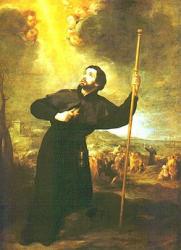
1506 - 1552 Person Name: F. Xavier Author of "I love, I love thee, Lord most high" in Song-Hymnal of Praise and Joy St. Francis Xavier, the great missionary saint of the Roman Catholic Church, was the son of Don John Giasso and Donna Maria d'Azpilqueta y Xavier; he was born at the castle Xavier, near Pampeluna, Spain, on April 7, 1506, and is known to history by his mother's name. At the age of eighteen he entered the University of Paris, where in due course he graduated, and then devoted himself to teaching. It was here that he became acquainted with Ignatius Loyola the founder of the Jesuits, who was then planning the colossal work which he afterwards accomplished. Xavier became one of the first nine of Loyola's converts, and the most enthusiastic of the little band. The date of the formation of the Order of the Jesuits is given as Aug. 15, 1534, and the place as Montmartre near Paris. We find Xavier at Venice with Loyola in 1537, where the visitation of a hospital for incurables was assigned to him. Here in the discharge of his duties he gave early evidence of his enthusiasm and self-devotion.
He subsequently visited Rome, where with Loyola and others of the Order he was brought, through the influence of the Rector of the University of Paris, who was then at Rome, to the notice of John III. of Portugal, who desired some of them for mission work in India. Circumstances led to the selection of Xavier for the work. He left Rome in March 1540, and set sail on April 7, 1541, for Goa, the chief city of the Portuguese possessions, where he arrived on May 6, 1542. From that time to the day of his death at Sancian, near Canton, on Dec. 22, 1552, he devoted himself to his work in a most heroic and devoted manner, visiting Travancore, Ceylon, Malacca, Japan, and other heathen lands with Cross in hand, and a burning zeal in his heart. Xavier's life has been written by many hands. The roll of deeds which he is said to have done, and the miracles he is said to have wrought, even to the raising of the dead, is long, but many of the alleged facts are open to the gravest doubt, and others are beyond belief. The hymns which are associated with Xavier's name are, "O Deus ego amo Te, Nam prior Tu amasti me," and "O Deus ego amo Te, Nee amo Te ut salves me.” That the first was written by him is most improbable, the evidence in his favour being absolutely nil. The second may possibly be his (see as above), it breathes his abnegation of self in every word, his spirit in every line. See Murray's Magazine for Oct. 1890, for an interesting account of Goa and its Cathedral, where Xavier lies buried.
--John Julian, Dictionary of Hymnology (1907)
==============
See also in:
Hymn Writers of the Church
Saint Francis Xavier
Michael Bruce
1746 - 1767 Author (attributed to) of "The Hour of My Departure's Come" in The Cyber Hymnal Bruce, Michael, son of a Scottish weaver, was born at Kinnesswood, Portmoak, Kinrossshire, Scotland, March 27,1746, and educated at the village school, Edinburgh University (where he first became acquainted with John Logan), and the Theological Hall of the Associate Synod, held at Kinross, under the Rev. John Swanston, intending ultimately to enter the ministry, a hope which was frustrated by his untimely death. To assist in procuring University fees and maintenance he for some time conducted a school, during the recess, at Gairney Bridge, and subsequently at Forrest Mill, near Tillicoultry. Whilst yet a student he died at Kinnesswood, July 5th, 1767.
[Also, see Logan, John]
The names of Michael Bruce and John Logan are brought together because of the painful controversy which has long prevailed concerning the authorship of certain Hymns and Paraphrases of Holy Scripture which are in extensive use in the Christian Church both at home and abroad. During the latter years of Bruce's short life he wrote various Poems, and also Hymns for a singing class at Kinnesswood, which were well known to his family and neighbours, and were eventually copied out by Bruce himself in a quarto MS. book, with the hope that some day he might see them in print. Immediately upon his death, in 1767, Logan called upon his father and requested the loan of this book that he might publish the contents for the benefit of the family. This was granted. Not till three years afterwards did a certain work, containing seventeen poems, and entitled Poems on Several Occasions , by Michael Bruce, 1770, appear, with a Preface in which it was stated that some of the Poems were by others than Bruce.
-- John Julian, Dictionary of Hymnology (1907)
Michael Bruce


 My Starred Hymns
My Starred Hymns


